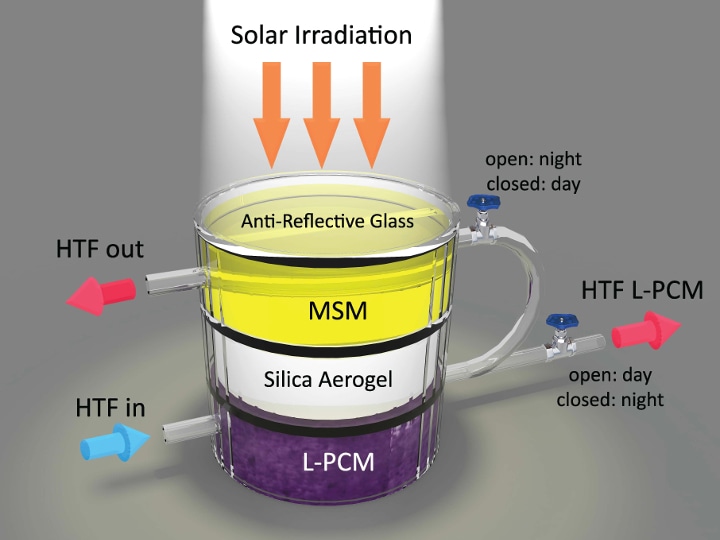 The hybrid device consists of a molecular storage material (MSM) and a localized phase-change material (L-PCM), separated by a silica aerogel to maintain the necessary temperature difference. Image Credit: University of Houston
The hybrid device consists of a molecular storage material (MSM) and a localized phase-change material (L-PCM), separated by a silica aerogel to maintain the necessary temperature difference. Image Credit: University of Houston
In contrast to solar cells and solar panels, which depend on photovoltaic technology for directly generating electricity, the hybrid device harnesses heat from the sun and stores it as thermal energy. It solves some of the problems that have delayed larger-scale adoption of solar power, suggesting a way for using solar energy 24/7, despite narrow sunlight hours, cloudy days, and other limitations.
The research detailed in a paper published recently in Joule integrates molecular energy storage and latent heat storage to create a unified harvesting and storage device for probable 24/7 operation. The scientists state a harvesting efficiency of 73% at small-scale operation and as high as 90% at large-scale operation.
Nearly 80% of stored energy was recovered at night, and according to the scientists, recovery during the daytime was even higher.
According to Hadi Ghasemi, Bill D. Cook Associate Professor of Mechanical Engineering at UH and a corresponding author for the paper, the high-efficiency harvest is partly based on the ability of the device to harness the complete spectrum of sunlight, harvesting it for instant use and turning the excess into molecular energy storage.
The device was built using norbornadiene-quadricyclane as the molecular storage material, an organic compound that has high specific energy and excellent heat release, while being stable over prolonged storage times. Ghasemi said the same concept could be applied using various materials, enabling performance—including efficiency and operating temperatures—to be enhanced.
According to T. Randall Lee, Cullen Distinguished University Chair professor of chemistry and a corresponding author, the device provides enhanced efficiency in a number of ways: The solar energy is stored in molecular form and not as heat, which gets dissipated over time, and the in-built system also decreases thermal losses because there is no need to convey the stored energy via piping lines.
During the day, the solar thermal energy can be harvested at temperatures as high as 120 degrees centigrade (about 248 Fahrenheit). At night, when there is low or no solar irradiation, the stored energy is harvested by the molecular storage material, which can convert it from a lower energy molecule to a higher energy molecule.
——T. Randall Lee, Study Corresponding Author and Cullen Distinguished University Chair Professor of Chemistry, University of Houston
According to Lee, who is also a principal investigator for the Texas Center for Superconductivity at UH, that enables the stored energy to create thermal energy at a higher temperature at night than at daytime—increasing the amount of energy available even when there is no sunshine.
Apart from Ghasemi and Lee, scientists involved with the research include first author Varun Kashyap, Siwakorn Sakunkaewkasem, Parham Jafari, Masoumeh Nazari, Bahareh Eslami, Sina Nazifi, Peyman Irajizad, and Maria D. Marquez, all from UH.